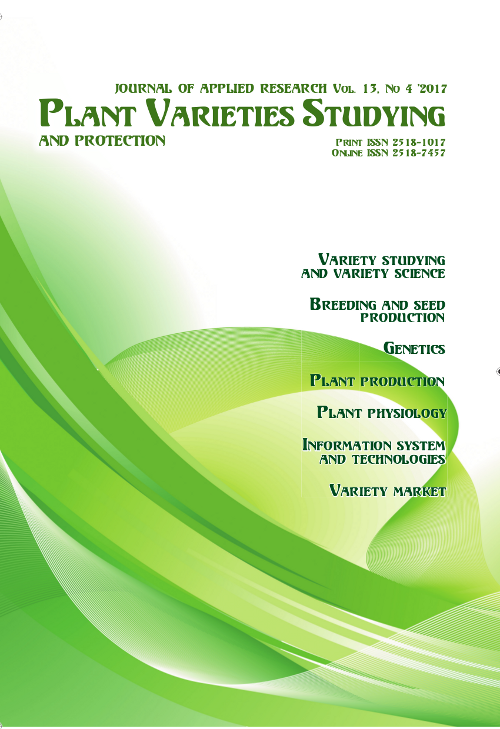Breeding indices of spring wheat varieties
DOI:
https://doi.org/10.21498/2518-1017.13.4.2017.117738Keywords:
spring wheat, breeding indices, correlation, varietiesAbstract
Purpose. To establish the most effective index figures for determination of breeding value of spring wheat genotypes.
Methods. Field and statistical ones. Index of prospectivity – IP, Finno-Scandinavian index – FSI, Mexican index – MI, Bila Tserkva index – BI, Poltava index – PI, index of spike linear density – ISLD, index of spike density – ISD were defined.
Results. During the investigation period, weather conditions differed from the long-term average annual indices for temperature regime, amount of precipitation and its distribution by month. Conditions of the growing season was the most favorable in 2016 (HTC = 1.1), insufficient level of humidity was specific for 2017 (HTC = 0.2). This allowed to define breeding indices for the soft wheat and spring durum wheat growing under different conditions. The analysis of the obtained data showed that the IP varied both in varieties and over the years, that indicated a various response of genotypes to vegetation conditions that existed during the growing years. Varieties of durum wheat ‘Slavuta’ and soft spring wheat ‘Struna myronivska’ were characterized by the high FSI. Such durum wheat varieties as ‘MIP Magdalena’, ‘MIP Raiduzhna’, ‘Kuchumivka’, ‘Kharkivska 41’, as well as the following soft spring varieties as ‘MIP Zlata’, ‘Oksamyt myronivskyi’, ‘Struna myronivska’, ‘Elehiya myronivska’ had a high level of MI. The spring wheat varieties have the highest indices of LSD and BI in 2016. IP during the investigation period was ranging from 2.3 to 4.5 in durum wheat varieties and from 2.2 to 6.4 in soft spring wheat. In breeding, it is important to use breeding indices, which should be included on the basis of traits that have a reliable correlation with yield index. SD indices (r = 0.53±0.08), BI (r = 0.42±0.08), MI (r = 0.41±0.08) were the most effective for durum spring wheat varieties in the year to be the best for humidification (2016), while PI (r = 0.39±0.07; r = 0.34±0.07 respectively) was the most effective for the soft wheat in 2016 and 2017. For the complex of breeding indices, the varieties of soft spring wheat (‘Struna myronivska’, ‘Simkoda myronivska’, ‘MIP Zlata’) and durum (MIP Mahdalena’, ‘MIP Raiduzhna’, ‘Slavuta’, ‘Kuchumivka’) were defined.
Conclusions. The indices SD, BI, MI were the most effective for durum spring wheat varieties and PI – for soft wheat. Selected spring wheat varieties showed the optimum ratio between investigated traits.
Downloads
References
Vasylkivskyi, S. P., & Kochmarskyi, V. S. (2016). Selektsiya i nasinnytstvo polovykh kultur [Breeding and seed production of field crops]. Myronivka: N.p. [in Ukrainian]
Fedin, M. A., Silis, D. Ya., & Smiryayev, A. V. (1976). Method of breeding indices. Selektsiya i semenovodstvo [Plant Breeding and Seed Production], 2, 53–59. [in Russian]
Szamák, I. (1979). Breeding of dwarf wheats by means of three indexes breaking correlations. Cereal Res. Commun., 7(3), 215–225.
Lozinska, T. P., & Vlasenko, V. A. (2010). The use of new breeding index for evaluation of the production process of soft wheat varieties. Vìsnik Sums’kogo nacìonal’nogo agrarnogo unìversitetu. Agronomìya ì bìologìya [Bulletin of Sumy National Agrarian University. Series: Agronomy and Biology], 10, 130–133. [in Ukrainian]
Tishchenko, V. N., & Chekalin, N. M. (2005). Geneticheskie osnovy adaptivnoy selektsii ozimoy pshenitsy v zone Lesostepi [Genetic Basis of Winter Wheat Adaptive Breeding in the Forest-Steppe Zone]. Poltava: N.p. [in Ukrainian]
Gulyaev, G. V., & Guzhov, Yu. L. (1987). Selektsiya i semenovodstvo polevykh kul’tur [Breeding and seed production of field crops]. (3rd ed., rev.). Moscow: Agropromizdat. [in Russian]
Selyaninov, G. T. (1937). Technique of agricultural characteristics of climate. In Mirovoy agroklimaticheskiy spravochnik [Global Agroclimatic Guide] (pp. 5–29). Leningrad–Moscow: Gidrometeoizdat. [in Russian]
Downloads
Published
How to Cite
Issue
Section
License
Copyright (c) 2017 Ukrainian Institute for Plant Variety Examination

This work is licensed under a Creative Commons Attribution-ShareAlike 4.0 International License.
Starting in 2022, the copyright to the publication remains with the authors
Our journal abides by the CREATIVE COMMONS copyright rights and permissions for open access journals.
Authors, who are published in this journal, agree to the following conditions:
- The authors reserve the right to authorship of the work and pass the first publication right of this work to the journal under the terms of a Creative Commons Attribution License, which allows others to freely distribute the published research with the obligatory reference to the authors of the original work and the first publication of the work in this journal.
- The authors have the right to conclude separate supplement agreements that relate to non-exclusive work distribution in the form in which it has been published by the journal (for example, to upload the work to the online storage of the journal or publish it as part of a monograph), provided that the reference to the first publication of the work in this journal is included.

























 Ukrainian Institute for Plant Varieties Examination
Ukrainian Institute for Plant Varieties Examination  Селекційно-генетичний інститут
Селекційно-генетичний інститут Institute of Plant Physiology and Genetics of the National Academy of Sciences of Ukraine
Institute of Plant Physiology and Genetics of the National Academy of Sciences of Ukraine
 The National Academy of Agrarian Sciences of Ukraine
The National Academy of Agrarian Sciences of Ukraine